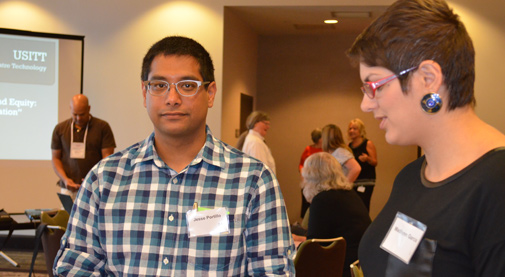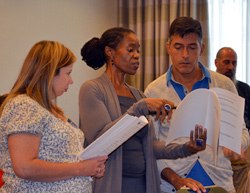News From Lea Asbell-Swanger, USITT President
Changing Perceptions

Members of the Diversity Committee, Jesse Portillo and Madilynn Garcia, preparing materials before the start of the diversity workshop in Nashville, Tennessee.
Photos/Barbara E.R. Lucas
Last month I promised to share more information about the diversity and inclusion workshop for the board, commissioners, and regional section leadership in Nashville in August. The following is an overview. I will not be able to do justice to the personal experience of each participant, nor would I presume to try, but I believe that it is important to share the process.
The first step was to get a snapshot of who would be participating, so before we arrived we were asked to complete a survey that asked us to self-identify in the following areas: age, gender, race, sexual identity/orientation, religion, ability, profession, and workplace. A list of options was provided, but in some cases choices outside of what one might find on a typical demographic questionnaire were available. It was the first opportunity in the process to realize that sometimes an entire segment of a community can be ignored by not providing accurate options to self-identify.

Carmen Morgan, center, lead the August workshop on diversity.
The survey also asked about each individual's perception of where along a defined continuum the industry is with respect to inclusion. We were asked to rank the broad arts sector, the production field, our own workplace, and USITT on a scale from exclusionary to inclusive with four transitional options along that path. This too was designed to help us determine how we view ourselves and our industry in order to help us define where we want to be and how best to get there.
Before the workshop, we were provided with a very comprehensive document which provided the objectives and agenda for the gathering, but more importantly some definitions and other resources to help inform the discussions. The results of the pre-session survey were also included.
The members of the diversity committee worked closely with Carmen Morgan, our external facilitator, prior to the session. Then, during the workshop, several of them presented information that would guide ensuing discussions and served as facilitators to smaller discussion groups to which we had been assigned. A key component to the success of the session was the following list of guidelines which enabled an honest discussion of potentially difficult perceptions and beliefs:
- Be honest
- Maintain respectful engagement
- Try to listen for understanding, not in order to debate
- Ask clarifying questions if something is not clear
- Agree to disagree, but please do not disengage
- Maintain confidentiality - discuss and share broader themes connected to the work when appropriate, but do not discuss specific stories or attribute conversations and decisions to specific individuals. When in doubt about what can be shared – ask
- Allow everyone to speak for themselves, not on behalf of an entire group
- Acknowledge that communication differences may be cultural (or may not be) so your discomfort with a communication style is not an excuse to disengage
- Challenge yourself - step out of your comfort zone
- Actively engage and participate
- Address conflict directly if it arises - see it as a learning opportunity
- Take issues/concerns to the source - involve those closest to an issue without venting to others that are not involved
- Recognize natural or imposed power dynamics and imbalances
- Acknowledge if you may have said something that was hurtful or insensitive to someone else
- No side conversations
- No talking on cell phones, texting, or working on computers or iPads during the session
Speak up if you feel a guideline is not being honored
To the credit of all involved, these guidelines were accepted and honored throughout the morning and I believe that they are an excellent tool that we can keep in mind as we continue these discussions in all aspects of our lives.
I must disclose that an emergency pulled me out of the workshop, so I was not present for much of the ensuing discussions, but the feedback was positive, except for the recurring theme that more time was needed. It is indeed encouraging that the consensus was a desire to continue discussions and efforts to improve diversity and inclusion, not just within USITT but our industry.
This was just one step in a process that, honestly, is still being defined and developed. Do not be surprised and please participate if requests for input come your way as a member of USITT. The path we take must be designed by all of us if it is to benefit any of us.
To be part of the 2015 Gateway program, apply before November 1. The portal will open October 1 at www.usitt.org/diversity.


We'd like to hear your comments on this story.
Please e-mail Lea at Lea.Asbell-Swanger@usitt.org.